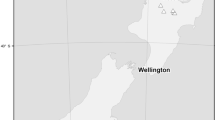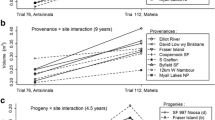Abstract
Key message
Eucalyptus pellita demonstrated good growth and wood quality traits in this study, with young plantation grown timber being suitable for both solid and pulp wood products. All traits examined were under moderate levels of genetic control with little genotype by environment interaction when grown on two contrasting sites in Vietnam.
Context
Eucalyptus pellita currently has a significant role in reforestation in the tropics. Research to support expanded of use of this species is needed: particularly, research to better understand the genetic control of key traits will facilitate the development of genetically improved planting stock.
Aims
This study aimed to provide estimates of the heritability of diameter at breast height over bark, wood basic density, Kraft pulp yield, modulus of elasticity and microfibril angle, and the genetic correlations among these traits, and understand the importance of genotype by environment interactions in Vietnam.
Methods
Data for diameter and wood properties were collected from two 10-year-old, open-pollinated progeny trials of E. pellita in Vietnam that evaluated 104 families from six native range and three orchard sources. Wood properties were estimated from wood samples using near-infrared (NIR) spectroscopy. Data were analysed using mixed linear models to estimate genetic parameters (heritability, proportion of variance between seed sources and genetic correlations).
Results
Variation among the nine sources was small compared to additive variance. Narrow-sense heritability and genetic correlation estimates indicated that simultaneous improvements in most traits could be achieved from selection among and within families as the genetic correlations among traits were either favourable or close to zero. Type B genetic correlations approached one for all traits suggesting that genotype by environment interactions were of little importance. These results support a breeding strategy utilizing a single breeding population advanced by selecting the best individuals across all seed sources.
Conclusion
Both growth and wood properties have been evaluated. Multi-trait selection for growth and wood property traits will lead to more productive populations of E. pellita both with improved productivity and improved timber and pulp properties.
Similar content being viewed by others
References
Apiolaza LA, Raymond CA, Yeo BJ (2005) Genetic variation of physical and chemical wood properties of Eucalyptus globulus. Silvae Genet 54:160–166
Baltunis BS, Wu HX, Powell MB (2007) Inheritance of density, microfibril angle, and modulus of elasticity in juvenile wood of Pinus radiata at two locations in Australia. Can J For Res 37:2164–2174
Blackburn D, Hamilton M, Harwood C, Innes T, Potts B, Williams D (2010) Stiffness and checking of Eucalyptus nitens sawn boards: genetic variation and potential for genetic improvement. Tree Gene Genomes 6:757–765
Borralho NMG, Cotterill PP, Kanowski PJ (1993) Breeding objectives for pulp production of Eucalyptus globulus under different industrial cost structures. Can J For Res 23:648–656
Brawner JT, Bush DJ, Macdonell PF, Warburton PM, Clegg PA (2010) Genetic parameters of red mahogany breeding populations grown in the tropics. Aust For 73:173–183
Brawner JT, Lee DJ, Hardner CM, Dieters MJ (2011) Relationships between early growth and Quambalaria shoot blight tolerance in Corymbia citriodora progeny trials established in Queensland, Australia. Tree Genet Genomes 7:759–772
Brawner JT, Meder R, Dieters M, Lee DJ (2012) Selection of Corymbia citriodora for pulp productivity. Southern For 74:121–131
Burdon RD (1977) Genetic correlation as a concept for studying genotype x environment interaction in forest tree breeding. Silvae Genet 26:168–175
Clarke B, McLeod I & Vercoe T (2009). Trees for farm forestry: 22 promising species. A report for the RIRDC/Land & Water Australia/FWPRDC Joint Venture Agroforestry Program. 239 pages
Costa e Silva J, Borralho NMG, Araujo JA, Vaillancourt RE, Potts BM (2009) Genetic parameters for growth, wood density and pulp yield in Eucalyptus globulus. Tree Genet Genomes 5:291–305
Dieters MJ, White TL, Hodge GR (1995) Genetic parameter estimates for volume from full-sib tests of slash pine (Pinus elliottii). Can J For Res 25:1397–1408
Dombro DB (2010) Eucalyptus pellita: Amazonia Reforestation’s red mahogany—an e-book for tropical tree investors. http://www.myreforestation.com. Accessed 25 Sep 2013
Downes GA, Worledge D, Schimleck L, French J, Beadle CL (2006) The effect of growth rate and irrigation on the basic density and kraft pulp yield of Eucalyptus globulus and E. nitens. New Zealand Forestry J 51:13–22
Dungey HS, Matheson AC, Kain D, Evans R (2006) Genetics of wood stiffness and its component traits in Pinus radiata. Can J For Res 36:1165–1178
Eldridge K, Davidson J, Harwood C, van Wyk G (1993) Eucalypt domestication and breeding. Clarendon, Oxford
Falconer DS (1981) Introduction to quantitative genetics. Longman, London and New York
Falconer DS, Mackay FC (1996) Introduction to quantitative genetics. Longman, Burnt Mill, England
Greaves BL, Borralho NMG, Raymond CA (1997) Breeding objective for plantation eucalypts grown for production of kraft pulp. For Sci 43:465–472
Griffin AR, Cotterill PP (1988) Genetic-variation in growth of outcrossed, selfed and open-pollinated progenies of Eucalyptus regnans and some implications for breeding strategy. Silvae Genet 37:124–131
Hamilton MG, Raymond CA, Harwood CE, Potts BM (2009) Genetic variation in Eucalyptus nitens pulpwood and wood shrinkage traits. Tree Genet Genomes 5:307–316
Hamilton MG, Potts BM, Greaves BL, Dutkowski GW (2010) Genetic correlations between pulpwood and solid-wood selection and objective traits in Eucalyptus globulus. Ann For Sci 67:511
Hardiyanto EB (2003) Growth and Genetic Improvement of Eucalyptus pellita in South Sumatra, Indonesia. In: Turnbull JW (ed) Eucalypts in Asia. Proceedings of an international conference held in Zhanjiang, Guangdong, People’s Republic of China. p. 82–88
Harwood CE (1998) Eucalyptus pellita: an annotated bibliography. CSIRO, Canberra
Harwood CE, Alloysius D, Pomroy P, Robson KW, Haines MW (1997) Early growth and survival of Eucalyptus pellita provenances in a range of tropical environments, compared with E-grandis, E-urophylla and Acacia mangium. New For 14:203–219
Hillis WE & Brown AG (1978) Eucalypts for wood production. CSIRO, Canberra
Hodge GR, Dvorak WS (2001) Genetic parameters and provenenance variation of Pinus caribaea var. hondurensis in 48 international trials. Can J For Res 31:496–511
Hodge GR, Dvorak WS, Uruena H, Rosales L (2002) Growth, provenance effects and genetic variation of Bombacopsis quinata in field tests in Venezuela and Colombia. For Ecol Manage 158:273–289
ITTO (2006) Guide on utilization of eucalyptus and acacia plantations in China for solid wood products. In: Technical report: improved and diversified use of tropical plantation timber in China to supplement diminishing supplies from natural forests. Chinese Academy of Forestry Beijing. http://www.itto.int/files/user/pdf/publications/PD%2069%2001/pd69-01-1%20rev2%28I%29%20e.pdf. Accessed Mar 2014
Kha LD, Thinh HH & Cuong NV (2003) Improvement of eucalypts for reforestation in Vietnam. In: Turnbull JW (ed) Eucalypts in Asia. Proceedings of an international conference held in Zhanjiang, Guangdong, People’s Republic of China. p 71–81
Lee JD, Brawner TJ, Smith ET, Hogg WB, Meder R & Osborne OD (2011) Productivity of plantation forest tree species in north-eastern Australia: A report from the Forest Adaptation and Sequestration Alliance. In. A report prepared for the Australian Government Department of Agriculture, Fisheries and Forestry Sunshine Coast. 50 pages
Leksono B, Kurinobu S, Ide Y (2006) Optimum age for selection based on a time trend of genetic parameters related to diameter growth in seedling seed orchards of Eucalyptus pellita in Indonesia. J For Res 11:359–364
Leksono B, Kurinobu S, Ide Y (2008) Realized genetic gains observed in second generation seedling seed orchards of Eucalyptus pellita in Indonesia. J For Res 13:110–116
Luo J, Arnold RJ, Aken K (2006) Genetic variation in growth and typhoon resistance in Eucalyptus pellita in south-western China. Aust For 69:38–47
MacDonald AC, Borralho NMG, Potts BM (1997) Genetic variation for growth and wood density in Eucalyptus globulus ssp. globulus in Tasmania (Australia). Silvae Genet 46:236–241
Matheson AC, Raymond CA (1984) Effects of thinning in progeny tests on estimates of genetic-parameters in Pinus-radiata. Silvae Genet 33:125–128
Meder R, Marston D, Ebdon N, Evans R (2011) Spatially-resolved radial scanning of tree increment cores for near infrared prediction of microfibril angle and chemical composition. J Near Infrared Spec 18:499–505
Miranda I, Pereira H (2002) Variation of pulpwood quality with provenances and site in Eucalyptus globulus. Ann For Sci 59:283–291
Miranda I, Almeida MH, Pereira H (2001) Influence of provenance, subspecies, and site on wood density in Eucalyptus globulus Labill. Wood Fiber Sci 33:9–15
Patterson HD, Thompson R (1971) Recovery of inter-block information when block sizes are unequal. Biometrika 58:545–554
Pliura A, Zhang SY, MacKay J, Bousquet J (2007) Genotypic variation in wood density and growth traits of poplar hybrids at four clonal trials. For Ecol Manage 238:92–106
Poke FS, Raymond CA (2006) Predicting extractives, lignin, and cellulose contents using near infrared spectroscopy on solid wood in Eucalyptus globulus. J Wood Chem Technol 26:187–199
Raymond CA (2002) Genetics of Eucalyptus wood properties. Ann For Sci 59:525–531
Raymond CA, Schimleck LR (2002) Development of near infrared reflectance analysis calibrations for estimating genetic parameters for cellulose content in Eucalyptus globulus. Can J For Res 32:170–176
Sanhueza RP, White TL, Huber DA, Griffin AR (2002) Genetic parameters estimates, selection indices and predicted genetic gains from selection of Eucalyptus globulus in Chile. For Genet 9:19–29
Savitzky A, Golay M (1964) Smoothing and differentiation of data by simplified least squares procedures. Anal Chem 36:1627–1639
Schimleck LR, Kube PD, Raymond CA (2004) Genetic improvement of kraft pulp yield in Eucalyptus nitens using cellulose content determined by near infrared spectroscopy. Can J For Res 34:2363–2370
Schimleck LR, Kube PD, Raymond CA, Michell AJ, French J (2006) Extending near infrared reflectance (NIR) pulp yield calibrations to new sites and species. J Wood Chem Technol 26:299–311
Tran HQ, Nguyen DK, von Arnold S, Jansson G, Ha HT, Clapham D (2010) Relationship of wood composition to growth traits of selected open-pollinated families of Eucalyptus urophylla from a progeny trial in Vietnam. New For 39:301–312
Wei X, Borralho NMG (1997) Genetic control of wood basic density and bark thickness and their relationships with growth traits of Eucalyptus urophylla in south east China. Silvae Genet 46:245–250
White TL, Hodge GR (1989) Predicting breeding values with applications in forest tree improvement. Kluwer Academic Publishers, London
White TL, Adams WT, Neale DB (2007) Forest Genetics. CAB International, Oxford
Williams ER, Matheson AC, Harwood CE (2002) Experimental design and analysis for tree improvement, 2nd edition. CSIRO, Collingwood
Zobel BJ, van Buijtenen JP (1989) Wood variation: its causes and control. Springer, Heidelberg, Germany
Acknowledgments
We would like to thank Mr Paul MacDonell and Mr Nguyen Van Chinh for their help with data and wood sample collection. Particular thanks to Dr. Katherine Raymont who provided instruction for scanning wood samples through an NIR instrument. We wish to thank the Institute of Forest Tree Improvement and Biotechnology (Vietnamese Academy of Forest Science), where the trials were undertaken, and collaborators for management and data collection.
Funding
This study was financially supported by the University of Queensland, the Commonwealth Scientific and Industrial Research Organisation, Department of Agriculture, Fisheries and Forestry (Australia) and Ministry of Education and Training (Vietnam)
Author information
Authors and Affiliations
Corresponding author
Additional information
Handling Editor: Jean-Michel Leban
Contributions by co-authors
Tran Duy Hung: conception and design of project (50 %), statistical analysis (80 %), wrote the paper (60 %).
Jeremy Brawner, Mark Dieters: conception and design of project (50 %), statistical analysis (20 %), wrote and edited paper (20 %).
Roger Meder, David Lee, Simon Southerton, Ha Huy Thinh: wrote and edited paper (20 %).
Appendix 1
Appendix 1
Rights and permissions
About this article
Cite this article
Hung, T.D., Brawner, J.T., Meder, R. et al. Estimates of genetic parameters for growth and wood properties in Eucalyptus pellita F. Muell. to support tree breeding in Vietnam. Annals of Forest Science 72, 205–217 (2015). https://doi.org/10.1007/s13595-014-0426-9
Received:
Accepted:
Published:
Issue Date:
DOI: https://doi.org/10.1007/s13595-014-0426-9




